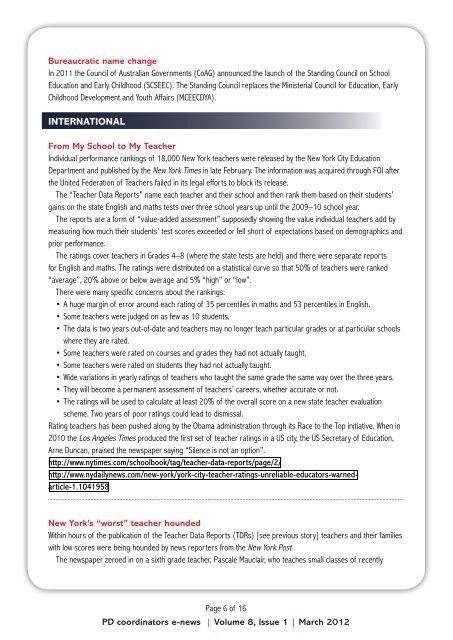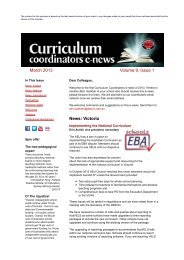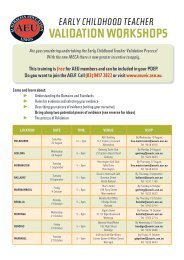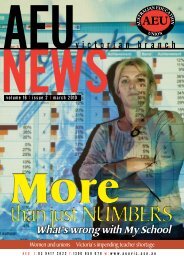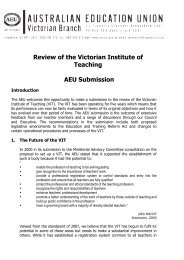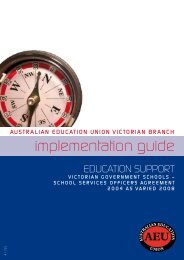PD Coordinators News - Australian Education Union, Victorian Branch
PD Coordinators News - Australian Education Union, Victorian Branch
PD Coordinators News - Australian Education Union, Victorian Branch
- No tags were found...
You also want an ePaper? Increase the reach of your titles
YUMPU automatically turns print PDFs into web optimized ePapers that Google loves.
Bureaucratic name changeIn 2011 the Council of <strong>Australian</strong> Governments (CoAG) announced the launch of the Standing Council on School<strong>Education</strong> and Early Childhood (SCSEEC). The Standing Council replaces the Ministerial Council for <strong>Education</strong>, EarlyChildhood Development and Youth Affairs (MCEECDYA).INTERNATIONALFrom My School to My TeacherIndividual performance rankings of 18,000 New York teachers were released by the New York City <strong>Education</strong>Department and published by the New York Times in late February. The information was acquired through FOI afterthe United Federation of Teachers failed in its legal efforts to block its release.The “Teacher Data Reports” name each teacher and their school and then rank them based on their students’gains on the state English and maths tests over three school years up until the 2009–10 school year.The reports are a form of “value-added assessment” supposedly showing the value individual teachers add bymeasuring how much their students’ test scores exceeded or fell short of expectations based on demographics andprior performance.The ratings cover teachers in Grades 4–8 (where the state tests are held) and there were separate reportsfor English and maths. The ratings were distributed on a statistical curve so that 50% of teachers were ranked“average”, 20% above or below average and 5% “high” or “low”.There were many specific concerns about the rankings:• A huge margin of error around each rating of 35 percentiles in maths and 53 percentiles in English.• Some teachers were judged on as few as 10 students.• The data is two years out-of-date and teachers may no longer teach particular grades or at particular schoolswhere they are rated.• Some teachers were rated on courses and grades they had not actually taught.• Some teachers were rated on students they had not actually taught.• Wide variations in yearly ratings of teachers who taught the same grade the same way over the three years.• They will become a permanent assessment of teachers’ careers, whether accurate or not.• The ratings will be used to calculate at least 20% of the overall score on a new state teacher evaluationscheme. Two years of poor ratings could lead to dismissal.Rating teachers has been pushed along by the Obama administration through its Race to the Top initiative. When in2010 the Los Angeles Times produced the first set of teacher ratings in a US city, the US Secretary of <strong>Education</strong>,Arne Duncan, praised the newspaper saying “Silence is not an option”.http://www.nytimes.com/schoolbook/tag/teacher-data-reports/page/2/http://www.nydailynews.com/new-york/york-city-teacher-ratings-unreliable-educators-warnedarticle-1.1041958New York’s “worst” teacher houndedWithin hours of the publication of the Teacher Data Reports (TDRs) [see previous story] teachers and their familieswith low scores were being hounded by news reporters from the New York Post.The newspaper zeroed in on a sixth grade teacher, Pascale Mauclair, who teaches small classes of recentlyPage 6 of 16<strong>PD</strong> coordinators e-news | Volume 8, Issue 1 | March 2012


